 |
Focus features two in-depth reviews each month of fine art, architecture, and design exhibitions at art museums, galleries, and alternative spaces around Japan. |
|
|
 |
 |
 |
Deeper and Wider: New Currents in Japan's Kogei Traditions
Susan Rogers Chikuba |
 |
Connection--Mugen by Tanabe Chikuunsai IV greeted shoppers and gallerygoers at an adjunct event to the nationwide kogei show held at the Nihombashi Mitsukoshi Main Store.
Photo by Susan Rogers Chikuba |
Undulating sheathes of woven bamboo twist under, around, and through one another in Connection--Mugen by Tanabe Chikuunsai IV, the centerpiece installation of a January show that spotlighted new directions in craft traditions featured annually at the venerable Japan Traditional Kogei Exhibition. Conceived by the Agency for Cultural Affairs and curated by Tama Art University professor Kazuko Todate, Greater Depth and Evolution: An Exhibition of the Expanding World of Traditional Crafts displayed 70 works by 66 select artists working in ceramics, textiles, lacquerware, metalwork, wood and bamboo, dollmaking, cloisonné, cut glass, and kirikane decorative metal leaf.
|
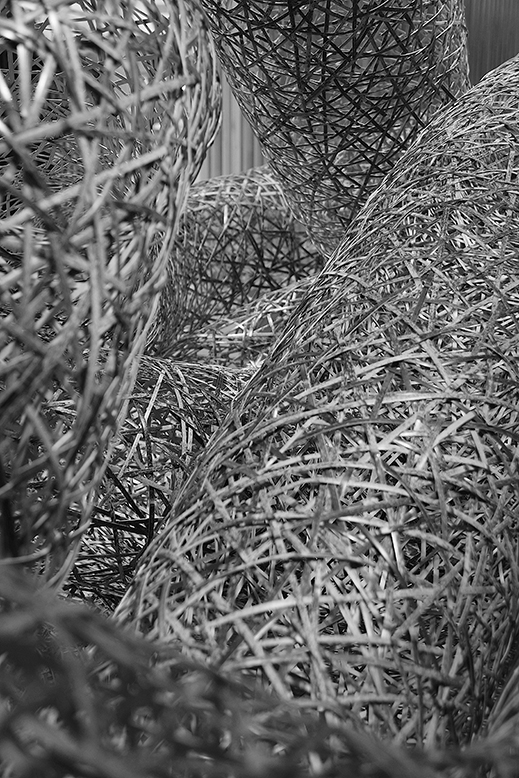 |
|
|
|
Tanabe plaited this latest iteration in his Connection series in a single day, using some 6,000 recyclable strips of torachiku tiger bamboo, each just eight millimeters in width.
Photo by Susan Rogers Chikuba
|
One of the most versatile artists working in bamboo art today, Chikuunsai IV has spread the Tanabe name beyond its Osaka roots to galleries as far-flung as Paris, Santa Fe, Hong Kong, Brussels, São Paulo, and New York. His huge site-specific installations, built solely from tiny hand-split strips of the material, draw on his family's 130-year lineage in the art of woven bamboo to address themes like sustainability, infinity, and the beauty of entanglements. Of the sculpture he created for this show he says, "It represents the way life's energy changes forms limitlessly and without beginning or end. Timeless power, real power that endures, is possible when it's woven of diversity. If you look closely, no two strips are alike -- each is unique in its coloring and patterns, just like us. That's what I wanted to express here, and the kind of world I'd like to live in."
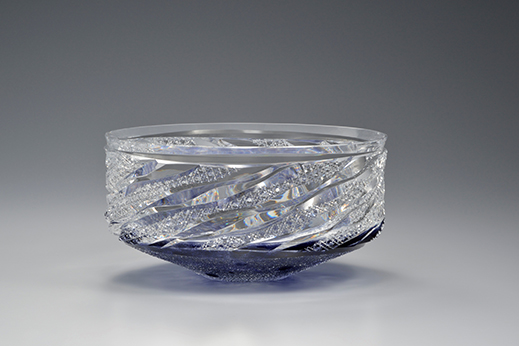 |
|
The title Gunjo (Ultramarine) speaks to the electric-blue depths of this cut-glass bowl by Masato Kigasawa. He uses thick glass for deeper cuts that maximize the material's refractive and reflective properties.
Photo courtesy of Isetan Mitsukoshi Ltd. |
Diversity and originality, or the creative ways craft artists explore their own unique place along the continuum of tradition and innovation, were key concepts for Todate, who drew on her years of experience on the screening committees of major craft exhibitions to invite 66 leading lights in 17 different specialties. With the youngest in their thirties, the eldest an octogenarian, and a dozen or so Living National Treasures among them, the ensemble revealed that originality may have less to do with novelty and more to do with origins: mastering the foundations of a craft to arrive, through exploration of its techniques, at one's own signature expression. On some tables, works by parent and child or teacher and disciple complemented one another; on others, synergies of shape, size, color and material were juxtaposed and played off each other like so much eye candy. With most of the works rendered either in earth tones or cool winter shades, Todate chose a warm, energetic red for the walls, and arranged things so that you could get up close to the art.
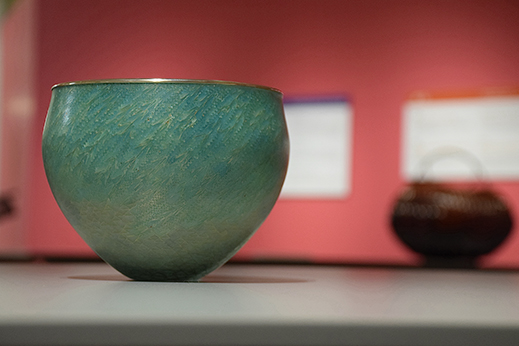 |
|
Sui (Blue-green), a plique-à-jour bowl by Michiko Matsumoto. In this cloisonné method the copper base is dissolved with acid so that only the glass-like enamel surface and silver wire outlines remain.
Photo by Susan Rogers Chikuba |
Take, for example, the elegant bowl pictured above by Michiko Matsumoto, in which the silver lines of the cloisons shimmer through the transparent enamel like lush water fronds flowing in a current. Next to it rested Koha (Light Waves), a cut-glass platter by Akira Watanabe. He layers gold dust and tiny colored beads among multiple glass sheets that he carves with decorative patterns before fusing them together -- an original technique he developed to capture light patterns inside the glass.
Earth, water, and fire come alive in Chimimoryo by Jun Isezaki, Holder of an Important Intangible Cultural Property (Living National Treasure) in the art of Bizen ware.
Photo by Susan Rogers Chikuba |
After the 2011 Tohoku earthquake and tsunami, Bizen potter Jun Isezaki created hope-inspiring sculptures he titled Chimimoryo (Spirit Denizens of Mountains and Rivers), after an animistic folk belief of the region. The kinetic energy of the stacked and twisted slabs evokes some primordial power whirling like a Sufi dancer between the earthly and ethereal realms. Isezaki coated the clay body with an iron-rich slip before firing, which can yield colors ranging from amber and warm scarlet to black. Called Kuro (Black) Bizen, the method is associated with the Inbe kilns of Old Bizen ware and has enjoyed a revival of late. Next to Isezaki's sculpture, Todate placed a flower vase by Ryuichi Kakurezaki, who pushes Bizen boundaries by wedging together a variety of local clays. The two works are equally dynamic, yet nothing alike.
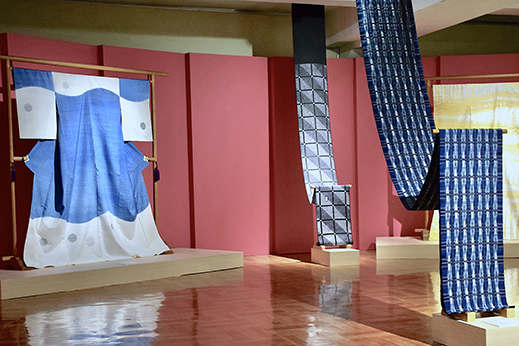 |
|
Obi sashes by Kan Takahashi and Miyuki Otaka, respectively featuring Yuzen resist-dyeing and tsumugi handspun silk, were hung from the ceiling and draped at a height enabling gallerygoers to appreciate the weaves up close from in front and behind.
Photo by Susan Rogers Chikuba |
The yarn-dyed (ikat) kimono on the left in the photo above is the work of Ryoko Murakami, Holder of an Important Intangible Cultural Property (Living National Treasure) in the art of woven tsumugi handspun silks. Murakami's background in graphic design is immediately evident in the bold, almost pop, look of her designs, which she pattern-weaves with botanical dyes she prepares herself. For this kimono, entitled "Kamome" (Seagull), she imagined "the play of earth energy" from a gull's perspective as it flies over the ocean, and used a weft-faced tapestry weave to build up pictorial blocks of color. If you're interested in kimono approached as a contemporary canvas, do try to see her works in person.
|
 |
|
|
|
Inochi o tsunagu mi deetsu (Date, the Lifegiving Fruit; detail) by Yosai Inoue is a toso doll, made by applying a modelling paste of starch and paulownia sawdust to a carved paulownia base, then finishing the form with layers of cloth and paper. In her hands the porcelain-like appearance belies the material.
Photo by Susan Rogers Chikuba
|
From good-luck daruma charms to theater puppets to figures displayed at festive turning points of the year, dolls of all shapes and sizes are about as old as Japanese culture itself -- even the dogu and haniwa figurines of prehistoric times are dolls, in essence, and ceramic dolls are familiar to people around the world as Japanese collectibles. Hiromine Nakamura, who hails from a four-generation family of dollmakers and was the youngest artist featured at this show, defines dolls as "an embodiment of someone's prayer." It follows that dollmakers, then, are tasked with giving form to such, and it's a mission Nakamura takes to heart. "Some say dolls don't belong in the craft tradition, because they have no utility. I don't share that view," he says. "These seemingly useless little beings are vessels for the pure purpose of conveying a person's deepest wish. At the very least, they are my offering to this absurd world we all live in."
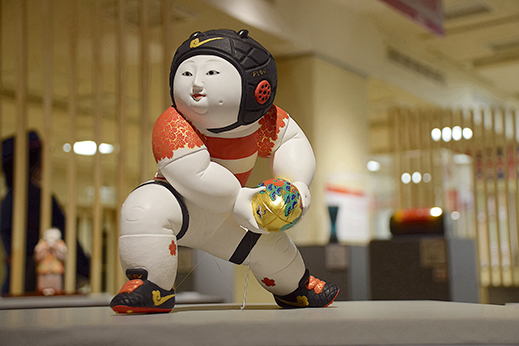 |
|
Sakura no tsuwamono (Cherry-Blossom Fighter) by Hiromine Nakamura.
Photo by Susan Rogers Chikuba |
Cherubic gosho palace dolls typically depict children at play and are said to bring good luck to the owner. (They're named after the Kyoto Imperial Palace, a reference to the dolls' origin four centuries ago as gifts from the court to visiting daimyo lords.) Nakamura worked from an unglazed pottery base to make this dimple-cheeked rugby player in a cherry-blossom jersey. The golden ball, adorned with pine branches, cranes, and other signs of longevity, signifies energy as he readies to fire a pass. The word "flow" appears on his helmet and the tongues of his cleats. A stylized cloud -- a whirling puff of energy and a classic auspicious symbol in Asian iconography -- is Nakamura's humorous nod to the Nike swoosh. Maybe with the right campaign, figures like this will become modern-day alternatives to the helmeted warrior dolls traditionally displayed in homes once a year as prayers for the development of boys with fighting spirit.
 |
|
Hyori (Inside-Out) vase by porcelain artist Akira Wada.
Photo courtesy of Isetan Mitsukoshi Ltd. |
It's said that, to a sculptor, every block of stone has a statue in it -- and that is how Akira Wada approaches his work in white porcelain. Where another potter might start with eight kilograms of clay to shape a vase like the one above, Wada begins with three times that amount and, working with just three simple shaping tools, sets about freeing the image he holds in his mind. He has also set a precedent among his peers in Japan by using no glossy glaze, preferring to let the matte finish highlight the simple beauty of the clay. When viewed from either side, the vase pictured above looks like a simple tube supported by two flanged wings. From the front or back, however, it transforms into this gently tapered polyhedron. The grooves of the ribbed design are deep at the base and flush at the top, giving rise to interesting shadows. "You get sharper edges when the surface is left unglazed," he says, and indeed all of his finely chiseled pieces seem almost to be folded of crisp paper.
 |
|
Though made the usual way, with silver wire and silver leaf applied to a copper base, there is nothing conventional about the restrained beauty of this cloisonné vase from Fumihiko Katsu's Suikoka (Shining Flowers in Water) series. Photo by Susan Rogers Chikuba |
With exhibitions and studio workshops largely on hold for the past two years, it's been difficult for craft artists like these to present their offerings. If you're seeking a one-of-a-kind gift or special keepsake from Japan, here are a few more worlds to explore:
- The playfully elegant metalwork of Masako Otsuki, who evokes the wind, sky, and waves in silver boxes and flower vessels she inlays with fine curving lines of gold-copper alloy and metal-foil inlay.
- Warm silvery-grey bog cedar boxes by woodworker Makoto Igarashi, who combines his loves of joinery and sculpting and "goes against the grain" of established styles by carving designs that interact with or accentuate the figured patterns of the wood.
- Bamboo flower baskets by Shosei Fujitsuka, who developed the unique method of shaping his strips for weaving into triangular rods. He lacquers one of the three sides of each strip in a different color, so that the geometric patterns he plaits magically shift hues depending on the angle from which they are viewed.
- The wheel-turned porcelain works of Masahiro Maeda, who approaches his craft as a painter would a canvas, scraping the base and meticulously masking it before covering it in colorful overglaze enamels "so as to obliterate the white ground." His studio and kiln are smack dab in Tokyo's bustling Roppongi district.
- For booklovers, Fired Earth, Woven Bamboo, a tour of contemporary Japanese ceramic and bamboo arts seen through the hands of 60 different craftspeople and authored by curator Kazuko Todate with Anne Nishimura Morse of the Museum of Fine Arts, Boston.
The annual Japan Traditional Kogei Exhibition launches in Tokyo around mid-September at the Nihombashi Mitsukoshi Main Store with a mind-numbing array of 600 or more works. It then moves on, scaled down in size, to cities in the Tokai, Kansai, Hokuriku, Sanuki, Tohoku, and Kyushu regions through early spring. If you are in Fukuoka, you can see the current 68th show at Mitsukoshi Department Store from 2 to 7 February, after which it will move to the Hiroshima Prefectural Art Museum from 16 February through 6 March. Browse the Japan Kogei Association's English handbook to learn more about the crafts shown each year, and click the link below to flip through a full digital catalog of all the works featured at the adjunct Greater Depth and Evolution show reviewed here.
All photo permissions are courtesy of Isetan Mitsukoshi Ltd. and the Agency of Cultural Affairs. |
 |
 |
Susan Rogers Chikuba
Susan Rogers Chikuba, a Tokyo-based writer, editor and translator, has been following popular culture, architecture and design in Japan for three decades. She covers the country's travel, art, literary and culinary scenes for domestic and international publications. |
|
 |
|